In November, U.S. Customs and Border Protection Commissioner Richard Gil Kerlikowske announced that the agency would expand its body-worn camera deployment in the coming months, using the cameras in “law enforcement operations such as checkpoints, vessel boarding and interdictions, training environments, and outbound operations at ports of entry.” This is a modest expansion to the border control agency’s ongoing pilot program, and it comes in spite of an internal evaluation by the agency’s Body-Worn Camera Working Group recommending caution because, among other reasons, the cameras might distract officers, lower officer morale, and fail to work in the harsh climate that border agents work in along the U.S.-Mexico border.
Adopting body-worn cameras as part of a larger project to make the agency more transparent and accountable is potentially a step in the right direction. But without the implementation of proper policies for camera use and public disclosure of footage, it won’t do much to overcome the agency’s historical lack of transparency and its general resistance to releasing video footage to the public. Unless CBP commits to greater transparency and external oversight as part of its body-worn camera program, the cameras may become just another tool of government surveillance wielded by the state without adequate oversight.
In an independent review of agency response to cases of alleged abuse in 2013, investigators found that CBP agents have “deliberately stepped in the path of cars … to justify shooting at the drivers” and have repeatedly fired their weapons through the border fence at Mexican nationals on Mexican soil. (The review was commissioned by CBP, but the agency has tried to keep it from coming to light.) Another investigation found that across 42 agent-involved killings between 2005 and 2013, there has not been a single case in which an officer is “publicly known to have faced consequences.”
At the same time, CBP has also frequently withheld video evidence of agent-involved shootings, even in high-profile cases like the 2012 shooting of José Antonio Elena Rodriguez. In August 2015, a federal judge also sanctioned the agency for destroying video evidence that it was required to preserve during an ongoing civil rights lawsuit. Agent Lonnie Ray Swartz, the officer involved in the case of José Antonio, has recently become the first agent ever charged with murder for shooting a Mexican national through the border fence. However, CBP and the U.S. Justice Department have continually refused to release existing video of the incident to the public. Swartz repeatedly fired his weapon through the fence, hitting 16-year-old José Antonio 10 times, including eight times in the back (and possibly reloading in the process) as the youth was walking away from the officer, supposedly on his way home from a basketball game. Swartz claims it was self-defense.
To read more, click here.





